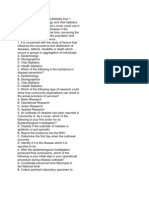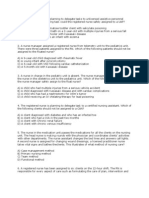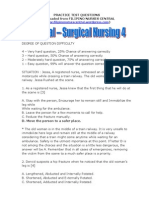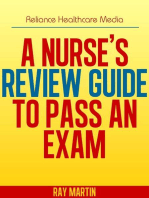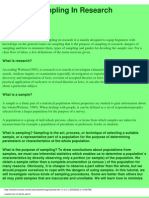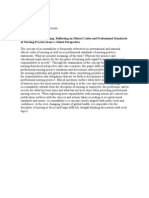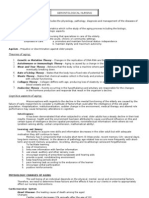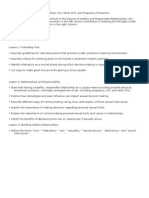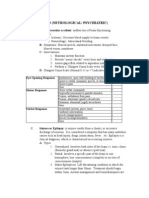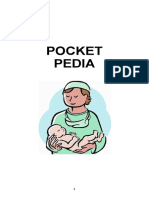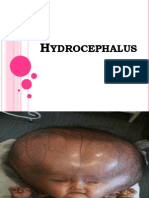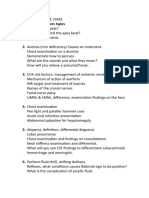CD
CD
Uploaded by
ec-bsCopyright:
Available Formats
CD
CD
Uploaded by
ec-bsCopyright
Available Formats
Share this document
Did you find this document useful?
Is this content inappropriate?
Copyright:
Available Formats
CD
CD
Uploaded by
ec-bsCopyright:
Available Formats
1. The nurse is aware that immunization of infants does not begin until 2 months of age because: A.
The neonatal spleen is unable to produce efficient antibodies B. Infants under 2 months are rarely exposed to infectious diseases C. The immunization would attack the immature infants body and produce the illness D. Maternal antibodies interfere with the development of active antibodies by the infant 2. Diphtheria, a disease of children, can be diagnosed with which of the following test? A. Dick B. Schick C. Widal D. Tuberculin Situation 1: HIV/AIDS - Mr. Sputnik, 56-year-old is an HIV suspect, admitted in the Pidiw ward, private room. 3. In assessing Mr. Sputniks condition for possible HIV positive, the least expected symptom to occur is: A. Night sweating C. Fungal infection in the mouth B. Fever D. Acute diarrhea 4. He is tentatively scheduled for blood transfusion. The test used in screening donated blood for antibody is: A. Culture and sensitivity test C. ELISA B. SGPT D. Schicks test 5. Which of the following is the least that you would do if youre suspecting him of developing an infection? A. Report findings to the doctor B. Get a piece of tissue from suspected site for biopsy C. Immediately culture the suspected site D. Document any evidence that you have 6. Pulmonary complications are most common problem in caring for AIDS patient, this is caused by: A. Kaposis Sarcoma C. Pneumocystis carinii B. Filtrable virus D. Staphylococcus bacteria 7. Your nursing care plan for Mr. Usher includes the following EXCEPT: A. Monitoring the occurrence of seizures C. Nutritional support B. Monitoring of fluid and electrolyte D. Protection from skin breakdown 8. A client complains of severe vulvar itching. The nurse recognizes that a client with moniliasis (Candida albicans) has a vaginal discharge that is: A. Yellow-green in color C. Fishy smelling B. Thick and white D. Purulent 9. When teaching a mother about communicable diseases, the nurse informs her that chickenpox is: A. Still communicable until all the vesicles have dried B. Still communicable even when only just dry scrubs remain C. No longer communicable after a high fever has subsided D. Not communicable as long as the vesicles are intact and surrounded by a red areola 10. Understanding that there is a need to protect susceptible persons from exposure to chickenpox during the acute phase, the nurse should question the mother of a child with chickenpox about relatives of friends who are receiving: A. Long-term anticonvulsant therapy B. Prolonged topical antibiotic therapy C. High doses of systemic steroid therapy D. Therapeutic doses of vitamins and minerals
11. To hasten the drying of the lesions and relieve the itch in a child with chicken pox, the nurse suggests that the mother should try: A. Using wet to dry saline dressings over the oozing vesicles B. Rubbing bacitracin (Bacitin) ointment into the open lesions C. Having the child wear mittens and cutting the fingernails short D. Patting the lesions gently with a paste of baking soda and warm water 12. The characteristic of diphtheria is a grayish white membrane, which can block breathing and swallowing. Which of the following terms pertains to this membrane? A. Pseudomembrane C. Papule B. Kopliks spot D. None of these 13. The bacteria which causes diphtheria is known as: A. Spirochete C. Widal B. Klebs-Loeffler D. Shigella 14. An intermediary host or vector for filariasis is: A. Mosquito B. Snail
C. Rodents
D. Flies
15. To prevent an infant from contracting infectious diarrhea, the nurse should instruct the mother in which topic? A. When to introduce solid foods into the infants diet B. How to prepare, handle and store infant formula C. When to have child immunized D. When to bring the infant to the clinic for routine check-ups 16. A female client with gonorrhoea informs the nurse that she had sexual intercourse with her boyfriend and asks the nurse, Would he have any symptoms? The nurse responds that in men the symptoms of gonorrhoea include: A. Impotence C. Urinary retention B. Scrotal swelling D. Dysuria Situation 2: HEPATITIS - Ms Samantha, a 25-year-old saleslady is admitted to the hospital with chief complains of fatigue, weakness, dark-yellow urine and clay-colored stool. She is diagnosed with acute viral hepatitis type B. On the fourth day of Ms Samanthas hospitalization, she developed jaundice, and strongly insisted that her visitors be restricted to her immediate family. 17. Potential patient problems that the nurse may encounter include all of the following except: A. Bleeding B. Pruritus C. Weight loss D. Hyperglycemia 18. Based on the data given, the most appropriate nursing diagnosis is: A. Depression related to feelings of guilt B. Anxiety related to feeling of impending doom C. Body image disturbance related to altered skin appearance D. Anger and hostility related to restriction of physical activity 19. The nurse observes that Ms Samantha has clay-colored stools. She asked you why is this so. The reason for this is that: A. Hepatic uptake of bilirubin is impaired B. Excretion of fecal urobilinogen is increased C. Conjugated bilirubin reenters the bloodstream D. Excretion of conjugated bilirubin into the intestines is decreased 20. To best reduce the risk of the spread of Ms Samanthas disease, the nurse must observe the proper disposal of the patients:
A. Urine and feces B. Nasogastric secretions
C. Used needles and syringes D. Feces and oral secretions
Situation 3. LEPROSY Leprosy is a chronic skin and peripheral nerve disease caused by Mycobacterium leprae. Prevalence rate was 65/1000 and has increased by 10 years. This is also known as Hansens disease. 21. During your health teaching class, one of the residents asked you how Leprosy is being transmitted. You know that the mode of transmission of this disease is/are: I. Skin contact III. Droplet infection II. Sexual contact IV. Sharing of food A. 1 and 2 B. 1, 2 and 3 C. 2 and 3 D. 1 and 4 22. A late sign and symptom of leprosy in male patients is enlargement of the breast also known as: A. Mammonastia B. Lagophthalmos C. Exophthalmus D. Gynecomastia 23. When drug therapy is being implemented by the DOH in all regions of the country, where is the control treatment done? A. RHU C. Barangay Captains Office B. BHS D. Midwifes residence 24. To prevent the occurrence of the Hansens disease which among the following vaccines is being administered? A. DPT B. MMR C. OPV D. BCG 25. Mr Zorro is believed to have malaria. The most important diagnostic test in malaria is: A. Smear and peripheral blood C. Blood leukocyte count B. Erythrocyte sedimentation rate D. Spleenic rupture 26. The nurse is reviewing the patients physical examination and lab that an important finding in malaria is: A. Spleenomegaly C. Elevated sedimentation rate B. Leukocytosis D. Erythocytosis 27. Mr Zorro asks the nurse how he could have prevented the disease. The nurse should explain the prophylaxis for control of malaria includes: A. Vaccination C. Prompt detection and effective treatment B. Client isolation D. Antibiotic therapy 28. Black-water fever occurs in some clients with malaria. Therefore, the nurse should observe Mr Zorro for: A. Diarrhea C. Low grade fever B. Coffee-brown emesis D. Dark-red urine 29. A serious complications of acute malaria is: A. Anemia and cachexia C. Changes in water and electrolytes B. Congested lungs D. Impaired peristalsis 30. When teaching about the drug therapy against Plasmodium falciparum, the nurse should include the fact that: A. Infections can generally be eliminated B. Transmission by the anopheles mosquito can occur C. Infections are controlled D. Immunity will prevent reinfection Situation 4: MEASLES Marley, 4-year-old, is brought to the RHU for cough fever and rashes. The doctor diagnosed her condition as measles.
31. Which of the following should you do first? A. Prepare nursing procedures B. Plan for your care regimen
C. Assess the patient D. Identify nursing diagnoses
32. You found a whitish, grayish pecks in the inner source of Marleys cheeks, which of the following refer to these? A. Marbili Eruptions C. Scarlet marks B. Kopliks spots D. Strawberry tongue 33. Which of the following procedure should you teach Marleys sister when Marley has fever at home? A. Proper positioning C. Isolation technique B. Hot sitz bath D. Tepid sponge bath 34. Which of the following complications should be watched? A. Meningitis C. Otitis media B. Pneumonia D. Laryngitis 35. A child is admitted with a diagnosis of meningococcal meningitis. The nurse is aware that isolation: A. Of any kind is not required B. Will be required for seven days C. Must be maintained during the incubation period D. Is required for 24 hours after onset of antibiotic therapy 36. The physicians orders for a child admitted with meningitis include specific isolation. The nurse understands that the child be placed on: A. Reverse isolation C. Respiratory isolation B. Enteric precaution D. Syringe and needle precautions 37. A child with meningitis suddenly assumes an opisthotonic position. The nurse should place the child in a: A. Side-lying position C. High-fowlers position B. Knee-chest position D. Trendelenburg position 38. During the acute stage of meningitis, a 3 year-old child is restless and irritable, which of the following would be most appropriate to institute? A. Limiting conversation with the child B. Keeping extraneous noise to a minimum C. Allowing the child to stay in the bath tub D. Performing treatments quickly 39. When interviewing the parents of a 2-year-old died, a history of which of the following illness would lead the nurse to suspect pneumococcal meningitis. A. Bladder infection C. Fractural clavicle B. Middle ear infection D. Septic arthritis 40. Paris, 1 month, is brought by her mother to the RHU for inability to feed well, cough and abnormal sleep. Which classification of pneumonia is she suffering from? A. Very severe C. Cough and cold B. No pneumonia D. Severe 41. If Paris needs procaine penicillin, what unit dose is given at the RHU before referring her to the district hospital? A. 600,000 B. 200,000 C. 300,000 D. 400,000
42. If Paris needs home care, which one of the following should be taught to the mother? A. Bring to the RHU clinic daily C. Give antibiotics for 5 days B. Clear nose if it interfere with feeding D. Weigh Paris every morning Situation 5: RABIES Brock, age 9 was bitten by a dog on his way home from school. When his father knew about this, he wanted the dog killed at once. 43. When Brock was brought to the health center, you interviewed Brock and his father to take the history. Before seeing a doctor, you told Brocks father not to kill the dog because the dog: A. Needs to be given vaccine C. Should be experimented for Negri bodies B. Must be confined in a cage D. Has to be observed for 10 days 44. You assisted the doctor in cleaning the wound of Brock with soap and water. The wound was opened and the doctor ordered anti-rabies serum which will be inoculated in which site? A. Abdominal wall C. Gluteus muscle B. Deltoid of the patient D. On the wound 45. Sight and sound of water as well as drip of the faucet disturb a patient with rabies, which one should you do first? A. Place the patient near the window C. Sponge only with warm face cloth B. Cover the IV bottle with brown paper D. Keep patient clean and quiet 46. Nursing intervention as prevention of injury when rabies patient is having convulsion. You tell the family or watcher to: A. Call you when patient is having convulsion B. Give sedative so patient can sleep C. Stay with the patient all the time D. Restraint the patient and ring the buzzer 47. Rabies vaccine is given to the patient with caution to prevent paralysis. You explain to Brock who has wound on his face and neck his schedule of injection which is: A. Two doses every other day for 2 weeks B. One dose daily for 14 days C. 2 doses daily in 7 days and one dose daily for another 7 days D. One massive dose in one day 48. The drug of choice used for Schistosomiasis is: A. Dapsone B. Fuadin C. Penicillin D. Chloroquine 49. The nurse in an adolescent clinic is aware that an early diagnosis of syphilis is important and its presence is often determined by: A. Evidence of a rash C. A discharge from the penis B. A lesion on the penis D. Multiple gummatous lesions 50. The physician diagnosed that a client has late stage syphilis. When obtaining a health history, the nurse recognized that the statement by the client that would most support this diagnosis would be: A. I noticed a wart on my penis. B. I have sores all over my mouth. C. Ive been having trouble keeping my balance. D. I have difficulty in urinating. Situation 6: TUBERCULOSIS The burden of infectious disease in our country is still heavy, as denounced by the Department of Health. One of the leading causes of morbidity is still pulmonary tuberculosis (PTB). 51. Tuberculosis is a primary disease caused by Tubercle bacilli. Which mode of transmission is extremely contagious? A. Ingestion of food C. Animal handling B. Airborne D. Skin contact 52. Which one of the following should a nurse do to detect the prevalence of PTB?
A. Bladder smear C. Skin scraping B. Organ biopsy D. PPD testing 53. Which of the following is a priority objective in PTB control? A. Sputum treatment C. BCG immunization B. Reduction of risk D. Identification of positive case 54. As a nurse, which of the following basic preventive actions is done to eradicate PTB? A. Health teachings B. Improvement of external environmental condition C. Distribution of medicines D. Referral to health centers 55. When an older person is affected with PTB, which of the following measures will you advise to effectively prevent the spread of the disease to other members of the family? A. Cover mouth and nose when coughing or sneezing B. Isolate the person C. X-ray members of the family D. Continue taking medications 56. Diseases which are caused by infectious agent that can be transmitted from an infected person to susceptible host in direct contact or thru a break in the skin/mucous membrane are known as: A. Communicable diseases C. Contagious diseases B. Infectious diseases D. Non-communicable diseases 57. Diseases which are easily transmitted from one person to another by direct or indirect contact is: A. Communicable diseases C. Contagious diseases B. Infectious diseases D. Non-communicable diseases 58. Direct contact means: A. Transmission through contaminated articles B. Transmission through infected food and water C. Transmission through fomites D. Person to person transmission 59. The time interval between the first exposure to the appearance of first signs and symptoms is known as: A. Period of Illness C. Incubation period B. Prodromal stage D. Convalescence 60. The promotion of an impending attack of a disease is known as: A. Incubation period C. Convalescence B. Period of Illness D. Prodromal period 61. The law mandating compulsory immunizations of children below 8-year-old is: A. PD 919 B. PD 911 C. PD 996 D. PD 163 62. The Philippines Code on sanitation is embodied in: A. PD 856 B. PD 886 C. PD 568 D. PD 586 63. The limitation of the freedom of movement based on the longest incubation period is: A. Isolation B. Quarantine C. Sterilization D. Disinfecction 64. The pathognomonic sign of diphtheria is: A. Pseudomembrane C. Dry metallic cough B. Bull neck D. Kopliks spot 65. The test that determine a persons susceptibility to diphtheria is: A. Schicks test C. Nose and throat swab B. Moloneys test D. ADS 66. Whooping cough or pertussis is communicable during the: A. Paroxysmal stage C. Convalescent stage B. Catarrhal stage D. Prodromal stage 67. Mantoux test is interpreted after: A. 24 hours B. 48 hours C. 72 hours D. 102 hours 68. The pathognomonic sign of pneumonia is: A. Kopliks spot C. Cough that ends in a whoop B. Fever D. Rusty sputum
69. Bacillary dysentery of shigellosis is characterized by: A. Diarrhea with tenesmus C. Blood streaked mucoid stool B. Rice-watery stool D. Diarrhea with borborygmi 70. All of the following are general signs of the presence of helminthes except: A. Pot belly B. Obesity C. Voracious appetite D. Anemia 71. The test most suitable in the diagnosis of Enterobiasis is: A. Ultrasound C. Chest x-ray B. Scotch tape test D. Electric tape test 72. German measles is also known as: A. Rubeola B. Rubella C. Varicella D. Shingles 73. The pathognomonic sign of tetanus is: A. Risus sardonicus C. Tonic spasm B. Lockjaw D. Opisthotonus 74. All of the following infest children via the fecal-oral route except: A. Ascaris B. Pinworm C. Hookworm D. Amoeba 75. Which of the following is not applicable to parasitism? A. Avoid wading in mud and water B. Proper waste disposal of both human and animal C. Cover the mouth when sneezing and coughing D. Wash hands carefully before and after eating 76. When a disease occurs in an on and off manner, its occurrence is said to be: A. Sporadic B. Endemic C. Epidemic D. Pandemic 77. When a disease is constantly present in a community, its occurrence is termed as: A. Sporadic B. Endemic C. Epidemic D. Pandemic 78. When there is an increase in the number of cases from the expected occurrence of the disease is said to be: A. Sporadic B. Endemic C. Epidemic D. Pandemic 79. Pidiw, 3-year-old, developed fever, cough, conjunctivitis and red spots all over her face and body. The above signs indicate: A. Influenza B. Poliomyelitis C. Primary complex D. Measles 80. Periodic cycle of fever, chills and profuse sweating are characteristics of: A. Influenza B. Tuberculosis C. Malaria D. Pneumonia 81. Tetanus neonatorum maybe prevented by: A. Aseptic technique in cord care B. Advising hospital delivery C. Tetanus toxoid immunization of pregnant mothers D. Immediate newborn care 82. You suspect that Tatay is sick of Tuberculosis for correct diagnosis and treatment you advise him to go to the health center for: A. Blood examination C. Tuberculin test B. Sputum smear D. Urine examination 83. Since the younger child was 9-months-old at the time of your visit, he should have received the following immunization: A. BCG and DPT C. BCG, DPT and OPV B. BCG, DPT, OPV, Hepa B and Measles D. BCG, DPT and measles 84. Oral-polio vaccine is given at the age of: A. 6 weeks in 2 doses at 4 weeks interval C. 6 weeks in 3 doses at 4 week interval B. 9 months in one dose only D. 4 weeks in 2 doses at 4 weeks interval 85. Measles vaccine is given at the age of: A. 9 months in one dose only C. 9 weeks in 2 doses at 4 weeks interval B. 2 weeks in 3 doses at 4 weeks interval D. 9 weeks in one dose only 86. Presidential Proclamation No. 6 provides for: A. Implementation of the united goal on Universal Child Immunization B. Compulsory immunization for infants and children below 8-year-old
C. Implementation of environmental sanitation practices D. Implementation of primary health care 87. A 2-year-old child was brought to the health center because of cough which occurs series of short rapid coughs followed by crowning sound or a whoop, childs eyes are bulging and sometimes vomiting is observed, these symptoms are indicative of: A. Diphtheria B. Influenza C. Pertussis D. Rubeola 88. If a dog bites a person it should be: A. Leashed and observed for 10 days B. Killed immediately C. Brought to the veterinarian for examination to determine presence of rabies in the blood D. None of these 89. The terminal stage of the HIV infection is: A. Respiratory disease C. Acquired immunodeficiency syndrome B. Gastrointestinal disease D. Neurological disease 90. Diarrhea is best judged on the basis of: A. Consistency B. Frequency C. Amount D. Odor 91. The most dangerous complication of diarrhea for child is: A. Dehydration C. Pneumonia B. Fever D. Proneness of infection 92. The pathognomonic sign of meningitis is: A. Widened pulse pressure C. Opisthotonus B. Nuchal rigidity D. Kernigs sign 93. The mode of transmission of meningitis is: A. Fecal-oral route B. Droplet C. Sexual intercourse D. Blood transfusion 94. Poliomyelitis is another preventable childrens disease. This is transmitted through the following except: A. Oral route through pharyngeal secretions B. Insects and rodents C. Fecal-oral route D. Contaminated milk or foodstuff 95. Reservoir of polio virus is: A. Milk/foodstuff C. Insects B. Contaminated soil D. Man 96. Immunity of poliomyelitis can be obtained from: A. 2 doses of OPV at 8 weeks interval C. 3 doses of OPV at 4 weeks interval B. 3 doses of OPV at 8 weeks interval D. 2 doses of OPV at 4 weeks interval 97. Which program is active to identify increase risk of AIDS? A. AIDS prevention C. AIDS national council B. AIDS surveillance D. Sentinel site nationwide 98. Imang, a 3-year-old girl came to RHU due to fever unresponsiveness to antibiotics. She showed her Strawberry tongue. Which among the following syndrome is her diagnosis? A. Karaki fever B. Igarashi fever C. Kawasaki fever D. Nagasaki fever 99. Mode of transmission of leprosy aside from skin to skin contact is by: A. Sharing tool B. Sexual contact C. Borrowing utensils D. Droplet infection 100. The drug of choice for patient with typhoid fever is: A. Cefuroxime B. Chloramphenicol C. Penicillin D. Paracetamol
You might also like
- Infectious Diseases of Central Nervous SystemDocument1,684 pagesInfectious Diseases of Central Nervous SystemLuciano Arraes100% (2)
- Plab Emergency Medicine CompleteDocument141 pagesPlab Emergency Medicine CompleteSyedKashifAli100% (1)
- CD One Exanthem GiDocument7 pagesCD One Exanthem GiNae OrdanozoNo ratings yet
- Community Health Nursing Exam 4Document7 pagesCommunity Health Nursing Exam 4Hannah BuquironNo ratings yet
- MULTIPLE CHOICE. Read The Following Questions and Choose The Best Answer by Shading TheDocument14 pagesMULTIPLE CHOICE. Read The Following Questions and Choose The Best Answer by Shading ThePrince Mark BadilloNo ratings yet
- CHNDocument14 pagesCHNJoyVee Pillagara-De LeonNo ratings yet
- Np4 np5Document71 pagesNp4 np5Erika SapieraNo ratings yet
- Nle NP1Document8 pagesNle NP1dammenoelNo ratings yet
- NP2Document13 pagesNP2Vincent Mangulad AgtangNo ratings yet
- Community Health Nursing Part 1Document64 pagesCommunity Health Nursing Part 1Jim Ryan PauloNo ratings yet
- Community Health/Communicable Disease Nursing INSTRUCTIONS: Select The Correct Answer For Each of The Following Questions. Mark ONLYDocument11 pagesCommunity Health/Communicable Disease Nursing INSTRUCTIONS: Select The Correct Answer For Each of The Following Questions. Mark ONLYjcruzadaNo ratings yet
- NP4 Nursing Board ExamDocument5 pagesNP4 Nursing Board ExamNewb TobikkoNo ratings yet
- Nursing Test 2 (NP I)Document9 pagesNursing Test 2 (NP I)Yuxin LiuNo ratings yet
- Previous Board Exam Questions No RatioDocument56 pagesPrevious Board Exam Questions No RatioNovemia Rose TisonNo ratings yet
- Nursing Practice IVDocument11 pagesNursing Practice IVapi-3718174100% (1)
- CHNDocument7 pagesCHNRichard GeeNo ratings yet
- Pnle July 2013 DX Test (Np3) III ANSWER PRINTDocument29 pagesPnle July 2013 DX Test (Np3) III ANSWER PRINTPaul EspinosaNo ratings yet
- Answer and Rationale Compre IDocument18 pagesAnswer and Rationale Compre IKaren Feyt MallariNo ratings yet
- June 2008 NleDocument71 pagesJune 2008 NleCharm Tanya100% (1)
- Nursing Questions& AnswersDocument42 pagesNursing Questions& AnswersSanjeev Kumar100% (1)
- Community Health Nursing Achievement Test FIRST SEMESTER 2021-2022Document14 pagesCommunity Health Nursing Achievement Test FIRST SEMESTER 2021-2022Matelyn OargaNo ratings yet
- NLE Pre-Board December 2007 Practice 1Document13 pagesNLE Pre-Board December 2007 Practice 1Aijem RyanNo ratings yet
- 2021 July Compilation W AnswersDocument115 pages2021 July Compilation W Answersdandandandalandan 2No ratings yet
- Pnle Answer and Explantion 4Document12 pagesPnle Answer and Explantion 4Lloyd rafaelNo ratings yet
- Philippine NLE Board Exam: Community Health Nursing Question & Answer W/ RationaleDocument22 pagesPhilippine NLE Board Exam: Community Health Nursing Question & Answer W/ RationaleTisyl BebzNo ratings yet
- Community Health NursingDocument30 pagesCommunity Health NursingDarnell Adrian EstobioNo ratings yet
- Set A: NP1 Nursing Board Exam December 2006 Answer Key 'Foundation of Professional Nursing PracticeDocument16 pagesSet A: NP1 Nursing Board Exam December 2006 Answer Key 'Foundation of Professional Nursing PracticeElizabella Henrietta TanaquilNo ratings yet
- Set 4 - Diagnostic TestDocument13 pagesSet 4 - Diagnostic Testdanielkenneth deleñaNo ratings yet
- Nursing Practice IIDocument34 pagesNursing Practice IIWilmaBongotanPadawil0% (1)
- NURSING PRACTICE 3 Edited AnswerkeyDocument9 pagesNURSING PRACTICE 3 Edited Answerkeykim_liñanNo ratings yet
- Nursing Test 3 (NP Ii)Document16 pagesNursing Test 3 (NP Ii)Yuxin LiuNo ratings yet
- Scope of This Nursing Test I Is Parallel To The NP1 NLE CoverageDocument15 pagesScope of This Nursing Test I Is Parallel To The NP1 NLE CoverageHanah Kanashiro AlcoverNo ratings yet
- Professional Adjustment and ResearchDocument26 pagesProfessional Adjustment and ResearchjeshemaNo ratings yet
- NEURODocument4 pagesNEUROSabrina LarracasNo ratings yet
- Board EamDocument55 pagesBoard Eamjoycevillamor100% (1)
- Nle 2015 QuestionsDocument4 pagesNle 2015 QuestionsJona Suarez100% (1)
- M Vanguardia-McnpDocument11 pagesM Vanguardia-Mcnpmark OrpillaNo ratings yet
- NP2Document12 pagesNP2mhamaenphapa27100% (2)
- Nursing. Midwifery. Pharmacy. Medtech. CriminologyDocument5 pagesNursing. Midwifery. Pharmacy. Medtech. CriminologyJake CopradeNo ratings yet
- Nursing Department: Answer: RationaleDocument14 pagesNursing Department: Answer: RationaleEsmareldah Henry SirueNo ratings yet
- NP 1 Nurse Licensure Examination 2006 2007 2008Document63 pagesNP 1 Nurse Licensure Examination 2006 2007 2008Opaque ITNo ratings yet
- Nursing Practice 1Document16 pagesNursing Practice 1HailMarieSBarcenas100% (1)
- CHN Post TestDocument4 pagesCHN Post Testkingpin0% (1)
- Midterm Quiz ReviewerDocument4 pagesMidterm Quiz ReviewerLee BontuyanNo ratings yet
- NP1 Family Nursing 3Document2 pagesNP1 Family Nursing 3Jonas Marvin AnaqueNo ratings yet
- RECALL 6 np2Document24 pagesRECALL 6 np2shiplusNo ratings yet
- Community Health Nursing and Care of The Mother and ChildDocument12 pagesCommunity Health Nursing and Care of The Mother and ChildArnie Jude CaridoNo ratings yet
- Funda Board ExamDocument107 pagesFunda Board Examjoan olanteNo ratings yet
- CHN Uv PosttestDocument6 pagesCHN Uv PosttestMeeKo VideñaNo ratings yet
- Nursing Test 3 (NP Iv)Document16 pagesNursing Test 3 (NP Iv)Yuxin LiuNo ratings yet
- Rationale: A Leader Doesn't Have Formal Power and Authority But Influences The SuccessDocument32 pagesRationale: A Leader Doesn't Have Formal Power and Authority But Influences The SuccessJohn kananamanNo ratings yet
- Community Evaluation Exam 2022Document11 pagesCommunity Evaluation Exam 2022Ryan-Jay Abolencia100% (1)
- NPT 3Document8 pagesNPT 3chrizthineeNo ratings yet
- Practice Test Questions Downloaded From FILIPINO NURSES CENTRALDocument37 pagesPractice Test Questions Downloaded From FILIPINO NURSES CENTRALFilipino Nurses CentralNo ratings yet
- Pasar Rbe CutieDocument11 pagesPasar Rbe CutieElla RetizaNo ratings yet
- Nars and RN HealsDocument2 pagesNars and RN HealsSanibat EcnalNo ratings yet
- Dec 06 NP4Document12 pagesDec 06 NP4Roy SalvadorNo ratings yet
- PNLE Community Health Nursing Exam 5Document8 pagesPNLE Community Health Nursing Exam 5Denisse PalayNo ratings yet
- Community Health Nursing Exam 5Document9 pagesCommunity Health Nursing Exam 5ek.9006001100% (1)
- CHN IiDocument9 pagesCHN IiCarla PunoNo ratings yet
- Pre TEST CD Set 1Document5 pagesPre TEST CD Set 1Princess Mae MagadanNo ratings yet
- Mu Go 02 SamplingDocument11 pagesMu Go 02 SamplingShilpa GuptaNo ratings yet
- Icne Yale #15Document1 pageIcne Yale #15ec-bsNo ratings yet
- Emergency Nursing Post TestDocument7 pagesEmergency Nursing Post Testec-bs67% (3)
- Rontological NursingDocument8 pagesRontological Nursingec-bsNo ratings yet
- Rontological NursingDocument8 pagesRontological Nursingec-bsNo ratings yet
- Sex Education 1Document8 pagesSex Education 1ec-bsNo ratings yet
- Clinical Concept Map SIMSDocument3 pagesClinical Concept Map SIMSAlexia HuertaNo ratings yet
- Defining Characteristics Nursing Diagnosis Scientifc Analysis Plan of Care Nursing Interventions RationaleDocument3 pagesDefining Characteristics Nursing Diagnosis Scientifc Analysis Plan of Care Nursing Interventions Rationalesbo100% (1)
- Central Nervous System Tuberculosis: John M. LeonardDocument10 pagesCentral Nervous System Tuberculosis: John M. LeonardMarcela Catalina Fandiño VargasNo ratings yet
- Elena HepDocument2 pagesElena HepMirela IoanaNo ratings yet
- MeningitisDocument4 pagesMeningitisabdullmlik789No ratings yet
- Instant ebooks textbook Marvel Universe Crochet Kati Galusz download all chaptersDocument50 pagesInstant ebooks textbook Marvel Universe Crochet Kati Galusz download all chaptersdeziogurakre100% (3)
- Meningitis PDFDocument10 pagesMeningitis PDFAlfatahadi SNo ratings yet
- Neonatal InfectionDocument18 pagesNeonatal InfectionchinchuNo ratings yet
- Acute Bacterial MeningitisDocument49 pagesAcute Bacterial MeningitisKumara GuruNo ratings yet
- Neonatal InfectionsDocument41 pagesNeonatal Infectionsamid sultanNo ratings yet
- Management of Common Respiratory Infections in Children in IndiaDocument60 pagesManagement of Common Respiratory Infections in Children in IndiaSukumar SubuNo ratings yet
- Glass Coma ScaleDocument3 pagesGlass Coma ScaleRnspeakcomNo ratings yet
- Pocket PediaDocument76 pagesPocket PediaDonna Labaniego100% (1)
- 16 Microbiology MCQsDocument9 pages16 Microbiology MCQsomaromran50% (2)
- HydrocephalusDocument72 pagesHydrocephalusZharah RuzNo ratings yet
- MCQ FMS4 2009 FixDocument18 pagesMCQ FMS4 2009 Fixdanielgunawan92No ratings yet
- Unit-6 New Born IgnouDocument26 pagesUnit-6 New Born IgnouVijay MgNo ratings yet
- Ciw 861Document32 pagesCiw 861Dr Vikas GuptaNo ratings yet
- Collection and Processing of CSFDocument65 pagesCollection and Processing of CSFkai dollNo ratings yet
- Meningitis Vs Ensefalitis MeganDocument10 pagesMeningitis Vs Ensefalitis MeganFandi ArgiansyaNo ratings yet
- Body Fluids (Final)Document31 pagesBody Fluids (Final)Fatima ZuhraNo ratings yet
- Immunoglobulin G4-Related Hypertrophic Pachymeningitis: A Case-Oriented ReviewDocument11 pagesImmunoglobulin G4-Related Hypertrophic Pachymeningitis: A Case-Oriented ReviewErnesto ColqueNo ratings yet
- Hussain 2024Document6 pagesHussain 2024jose mendozaNo ratings yet
- Internal Medicine VivasDocument9 pagesInternal Medicine Vivasponcus payNo ratings yet
- Epidemiology and Management Og Meningococcal MeningitisDocument12 pagesEpidemiology and Management Og Meningococcal MeningitispriyankaNo ratings yet
- Meningitis Up To DateDocument27 pagesMeningitis Up To DateJonathan Gustavo MenaNo ratings yet
- Guide To LivingDocument59 pagesGuide To LivingPmsakda HemthepNo ratings yet
- Pathology of The Nervous SystemDocument163 pagesPathology of The Nervous SystemEmmanuel De Leon100% (1)









